Provenance Variations of Cretaceous Sandstones from Arkansas and Drainage Reorganization in Southern USA: Evidence from Detrital Zircon Ages
Abstract
1. Introduction
2. Cretaceous Sandstones of Southwestern Arkansas
2.1. Overview
2.2. Lower Cretaceous
2.3. Upper Cretaceous
2.4. Context for Sand Samples of This Study
3. Materials and Methods
4. Results
5. Discussion
5.1. Igneous Provinces of North America and Provenances of Arkansas Detrital Zircons
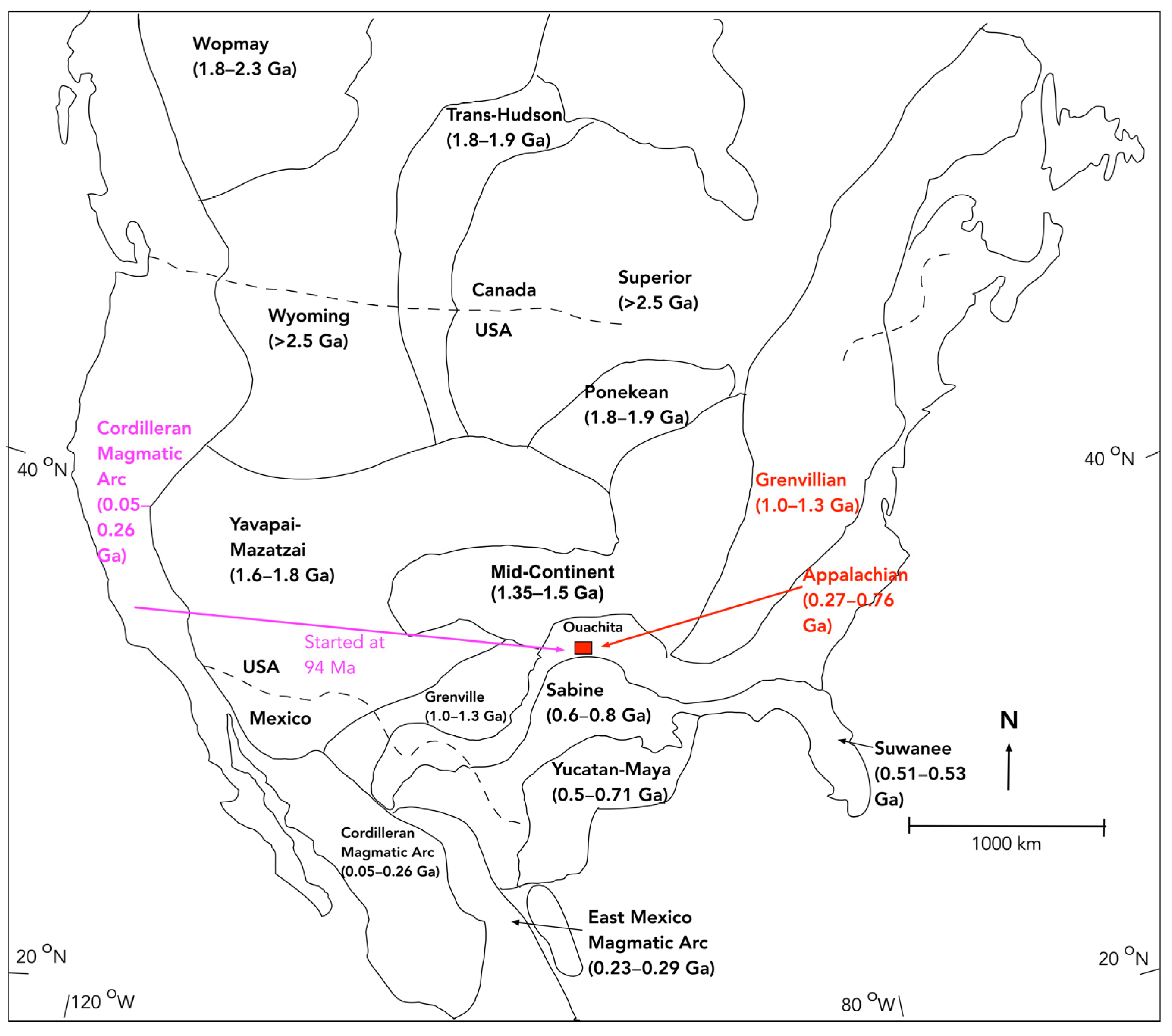
5.2. The Youngest Depositional Ages and Sedimentary Lag Times
5.3. Province Changes During Late Cretaceous
6. Conclusions
Supplementary Materials
Author Contributions
Funding
Data Availability Statement
Acknowledgments
Conflicts of Interest
References
- Gehrels, G.E. Detrital zircon u-pb geochronology applied to tectonics. Annu. Rev. Earth Planet. Sci. 2014, 42, 127–149. [Google Scholar]
- Grove, M.; Bebout, G.E.; Jacobson, C.E.; Barth, A.P.; Kimbrough, D.L.; King, R.L.; Zou, H.B.; Lovera, O.M.; Mahoney, B.J.; Gehrels, G.E. The Catalina Schist: Evidence for middle Cretaceous subduction erosion of southwestern north america. In Formation and Applications of the Sedimentary Record in Arc Collision Zones; Draut, A.E., Clift, P.D., Scholl, D.W., Eds.; Geological Society of American Special Paper; GeoScienceWorld: McLean, VA, USA, 2008; Volume 436, pp. 335–361. [Google Scholar]
- Moecher, D.; Samson, S. Differential zircon fertility of source terranes and natural bias in the detrital zircon record: Implications for sedimentary provenance analysis. Earth Planet. Sci. Lett. 2006, 247, 252–266. [Google Scholar] [CrossRef]
- Fedo, C.M.; Sircombe, K.; Rainbird, R. Detrital zircon analysis of the sedimentary record. In Zircon: Reviews in Mineralogy and Geochemistry; Hanchar, J.M., Hoskin, P.W.O., Eds.; De Gruyter: Berlin, Germany, 2003; Volume 53, pp. 277–303. [Google Scholar]
- Gao, Y.; Jiang, L.; Chen, W.Y.; Dong, H.K.; Jiang, F.J.; Zhao, W.; Feng, Y.Q.; Cao, L.; Liu, X.W. Tectonic evolution of the proto-paleo-tethys in the west kunlun orogenic belt: Constraints from u-pb geochronology of detrital zircons. Gondwana Res. 2025, 141, 213–227. [Google Scholar] [CrossRef]
- Grove, M.; Gehrels, G.E.; Cotkin, S.J.; Wright, J.E.; Zou, H.B. Non-laurentian cratonal provenance of late ordovician eastern klamath blueschists and a link to the alexander terrane. In Ophiolites, Arcs, and Batholiths: A Tribute to Cliff Hopson; Wright, J.E., Shervais, J.W., Eds.; Geological Sociaety of America Special Paper; GeoScienceWorld: McLean, VA, USA, 2008; Volume 438, pp. 223–250. [Google Scholar]
- Zhang, C.L.; Ye, X.T.; Zou, H.B.; Chen, X.Y. Neoproterozoic sedimentary basin evolution in southwestern tarim, nw china: New evidence from field observations, detrital zircon u–pb ages and hf isotope composition. Precambrian Res. 2016, 280, 31–45. [Google Scholar] [CrossRef]
- Liu, C.F.; Zhang, J.; Tang, L.; Yang, F.; Guo, J.T.; Zhou, C.; Cai, Z.W.; Bian, X.L.; Manikyamba, C. Detrital zircon u–pb geochronology and provenance of the neoproterozoic lower roan group, chambishi basin, north-eastern zambia: Implication for rift evolution of the congo craton. Geol. J. 2019, 55, 1245–1261. [Google Scholar] [CrossRef]
- Gehrels, G.E. Introduction to detrital zircon studies of paleozoic and triassic strata in western nevada and northern california. In Paleozoic and Triassic Paleogeography and Tectonics of Western Nevada and Northern California: Boulder, Colorado, Geological Society of America Special Paper; Soreghan, M.J., Gehrels, G.E., Eds.; Geological Society of America: Boulder, CO, USA, 2000; Volume 347, pp. 1–17. [Google Scholar]
- Sundell, K.E.; Saylor, J.E. Unmixing detrital geochronology age distributions. Geochem. Geophys. Geosystems 2017, 18, 2872–2886. [Google Scholar] [CrossRef]
- Vermeesch, P. Isoplotr: A free and open toolbox for geochronology. Geosci. Front. 2018, 9, 1479–1493. [Google Scholar] [CrossRef]
- Wang, C.; Zeng, L.T.; Lei, Y.P.; Su, M.; Liang, X.Q. Tracking the detrital zircon provenance of early miocene sediments in the continental sheld of the northwestern south china sea. Minerals 2020, 10, 752. [Google Scholar] [CrossRef]
- Jackson, W.T.; McKay, M.P.; Beebe, D.A.; Mullins, C.; Ionescu, A.; Shaulis, B.J.; Barbeau, D.L. Barbeau. Late cretaceous sediment provenance in the eastern gulf coastal plain (u.S.A.) based on detrital-zircon u-pb ages and th/u values. J. Sediment. Res. 2021, 91, 1025–1039. [Google Scholar] [CrossRef]
- McKay, M.P.; Jackson, W.T.; Hessler, A.M. Tectonic stress regime recorded by zircon th/u. Gondwana Res. 2018, 57, 1–9. [Google Scholar] [CrossRef]
- McKay, M.P.; Jackson, W.T.; Spurgeon, D.; Ionescu, A.; Shaulis, B.J. Detrital zircon geothermochronology reveals pre-alleghanian exhumation of regional mississippian sediment sources in the southern appalachian valley and ridge province. Geosphere 2021, 17, 1840–1860. [Google Scholar] [CrossRef]
- Blum, M.; Pecha, M. Mid-cretaceous to paleocene north american drainage reorganization from detrital zircons. Geology 2014, 42, 607–610. [Google Scholar] [CrossRef]
- Cohen, K.M.; Harper, D.A.T.; Gibbard, P.L. ICS International Chronostratigraphic Chart 2024/12. International Commission on Stratigraphy, IUGS. 2024. Available online: www.stratigraphy.org (accessed on 12 January 2025).
- Haley, B.R. Geologic map of arkansas. In State Map Series; US Geological Survey: Reston, VA, USA, 1993. [Google Scholar]
- Paces, J.B.; Miller, J.D. Precise U-Pb ages of Duluth complex and related mafic intrusions, northeastern minnesota–geochronological insights to physical, petrogenetic, paleomagnetic, and tectonomagmatic processes associated with the 1.1 ga midcontinent rift system. J. Geophys. Res. 1993, 98, 13997–14013. [Google Scholar]
- Compston, W.; Williams, I.S.; Meyer, C. U-Pb geochronology of zircons from lunar breccia 73217 using a sensitive high mass-resolution ion microprobe. J. Geophys. Res. 1984, 89, B525–B534. [Google Scholar]
- Schmitt, A.K.; Grove, M.; Harrison, T.M.; Lovera, O.M.; Hulen, J.; Waters, M. The guysers-cobb mountain magma system, california (part 1): U-pb zircon ages of volcanic rocks, conditions of zircon crystallization and magma residence times. Geochim. Cosmochim. Acta 2003, 67, 3423–3442. [Google Scholar] [CrossRef]
- Hu, Z.; Li, X.H.; Luo, T.; Zhang, W.; Crowley, J.L.; Li, Q.-l.; Ling, X.; Yang, C.; Li, Y.; Feng, L.; et al. Tanz zircon megacrysts: A new zircon reference material for the microbeam determination of u-pb age and zr-o isotopes. J. Anal. At. Spectrom. 2021, 36, 2715–2734. [Google Scholar]
- Zong, K.; Klemd, R.; Yuan, Y.; He, Z.; Guo, J.; Shi, X.; Liu, Y.; Hu, Z.; Zhang, Z. The assembly of rodinia: The correlation of early neoproterozoic (ca. 900 ma) high-grade metamorphism and continental arc formation in the southern beishan orogen, southern central asian orogenic belt (CAOB). Precambrian Res. 2017, 290, 32–48. [Google Scholar] [CrossRef]
- Liu, Y.S.; Gao, S.; Hu, Z.C.; Gao, C.G.; Zong, K.Q.; Wang, D.B. continental and oceanic crust recycling-induced melt–peridotite interactions in the trans-north china orogen: U–pb dating, hf isotopes and trace elements in zircons from mantle xenoliths. J. Petrol. 2010, 51, 537–571. [Google Scholar] [CrossRef]
- Liu, Y.S.; Hu, Z.C.; Gao, S.; Günther, D.; Xu, J.; Gao, C.G.; Chen, H.H. In situ analysis of major and trace elements of anhydrous minerals by la-icp-ms without applying an internal standard. Chem. Geol. 2008, 257, 34–43. [Google Scholar] [CrossRef]
- Ludwig, K.R. ISOPLOT 3.0: A Geochronological Toolkit for Microsoft Excel; Berkeley Geochronology Center Special Publication; Berkeley Geochronology Center: Berkeley, CA, USA, 2003. [Google Scholar]
- Saylor, J.E.; Jordan, J.C.; Sundell, K.E.; Wang, X.M.; Wang, S.Q.; Deng, T. Topographic growth of the jishi shan and its impact on basin and hydrology evolution, ne tibetan plateau. Basin Res. 2017, 30, 544–563. [Google Scholar] [CrossRef]
- Thomas, W.A.; Gehrels, G.E.; Greb, S.F.; Nadon, G.C.; Satkoski, A.M.; Romero, M.C. Detrital zircons and sediment dispersal in the appalachian foreland. Geosphere 2017, 13, 2206–2230. [Google Scholar] [CrossRef]
- McGuire, P.R. U-Pb Detrital Zircon Signature of the Ouachita Orogenic Belt. Master’s Thesis, Texas Christian University, Fort Worth, TX, USA, 2017. [Google Scholar]
- Schwartz, T.M.; Surpless, K.D.; Colgan, J.P.; Johnstone, S.A.; Holm-Denoma, C.S. Detrital zircon record of magmatism and sediment dispersal across the north american cordilleran arc system (28–48°N). Earth-Sci. Rev. 2021, 220, 103734. [Google Scholar] [CrossRef]
- Gehrels, G.E.; Dickinson, W.R.; Riley, B.C.D.; Finney, S.C.; Smith, M.T. Detrital zircon geochronology of the roberts mountains allochthon, nevada. In Paleozoic and Triassic Paleogeography and Tectonics of Western Nevada and Northern California: Boulder, Colorado, Geological Society of America Special Paper; Soreghan, M.J., Gehrels, G.E., Eds.; Geological Society of America: Boulder, CO, USA, 2000; Volume 347, pp. 19–42. [Google Scholar]
- Zou, H.B. Quantitative Geochemistry; Imperial College Press: London, UK, 2007; p. 304. [Google Scholar]
- Gifford, J.N.; Vitale, E.J.; Platt, B.F.; Malone, D.H.; Widanagamage, I.H. Detrital zircon provenance and lithofacies associations of montmorillonitic sands in the maastrichtian ripley formation: Implications for mississippi embayment paleodrainage patterns and paleogeography. Geosciences 2020, 10, 80. [Google Scholar] [CrossRef]
- Engebreson, D.C.; Cox, A.; Gordon, R.G. Relative motions between oceanic and continental plates in the pacific basins. Geol. Soc. Am. Spec. Pap. 1985, 206, 1–59. [Google Scholar]
- DeCelles, P.G.; Graham, S.A. Cyclical processes in the north american cordilleran orogenic system. Geology 2015, 43, 499–502. [Google Scholar] [CrossRef]
- Alsalem, O.B.; Fan, M.J.; Zamora, J.; Xie, X.Y.; Griffin, W.R. Paleozoic sediment dispersal before and during the collision between laurentia and gondwana in the fort worth basin, USA. Geosphere 2017, 14, 325–342. [Google Scholar] [CrossRef]
- Allred, I.J.; Blum, M.D. Early pennsylvanian sediment routing to the ouachita basin (southeastern united states) and barriers to transcontinental sediment transport sourced from the appalachian orogen based on detrital zircon u-pb and hf analysis. Geosphere 2021, 18, 350–369. [Google Scholar] [CrossRef]
- Kruskal, J.B. Multidimensional scaling by optimizing goodness of fit to a nonmetric hypothesis. Psychometrika 1964, 29, 1–27. [Google Scholar] [CrossRef]
- Vermeesch, P. Multi-sample comparison of detrital age distributions. Chem. Geol. 2013, 341, 140–146. [Google Scholar] [CrossRef]
- Gehrels, G.E.; Blakey, R.; Karlstrom, K.E.; Thimmmons, J.M.; Dickinson, B.; Pecha, M. Detrital zircon u-pb geochronology of paleozoic strata in the grand canyon, arizona. Lithosphere 2011, 3, 183–200. [Google Scholar]
- Zartman, R.E.; Howard, J.M. Uranium-lead age of large zircon crystals from the potash sulfur springs igneous complex, garland county, arkansas. Geol. Soc. Am. Spec. Pap. 1987, 215, 235–240. [Google Scholar]
- Barth, A.P.; Wooden, J.L.; Jacobson, C.E.; Probst, K. U-pb geochronology and geochemistry of the mccoy mountains formation, southeastern california: A cretaceous retroarc foreland basin. GSA Bull. 2004, 116, 142–153. [Google Scholar]
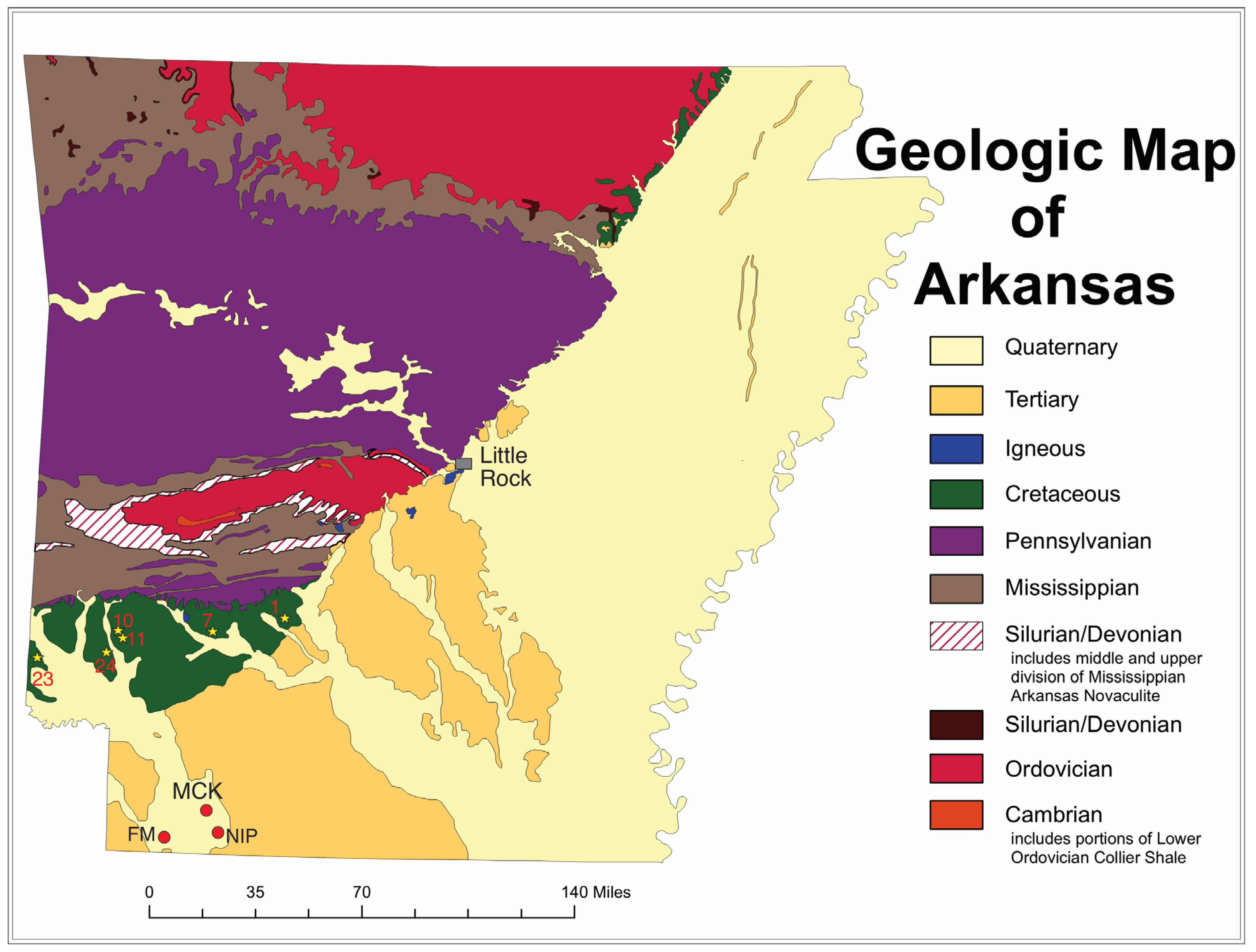
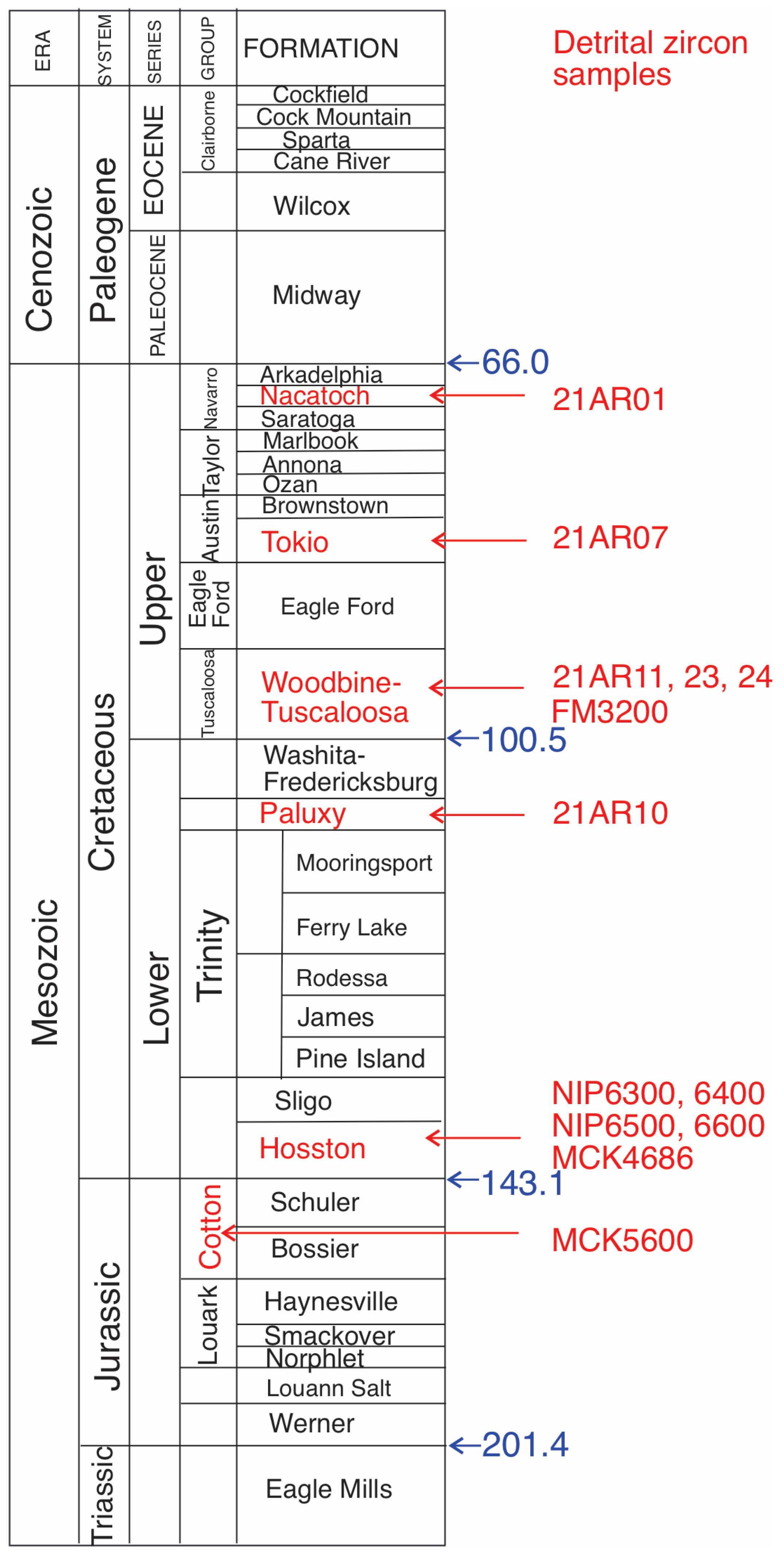


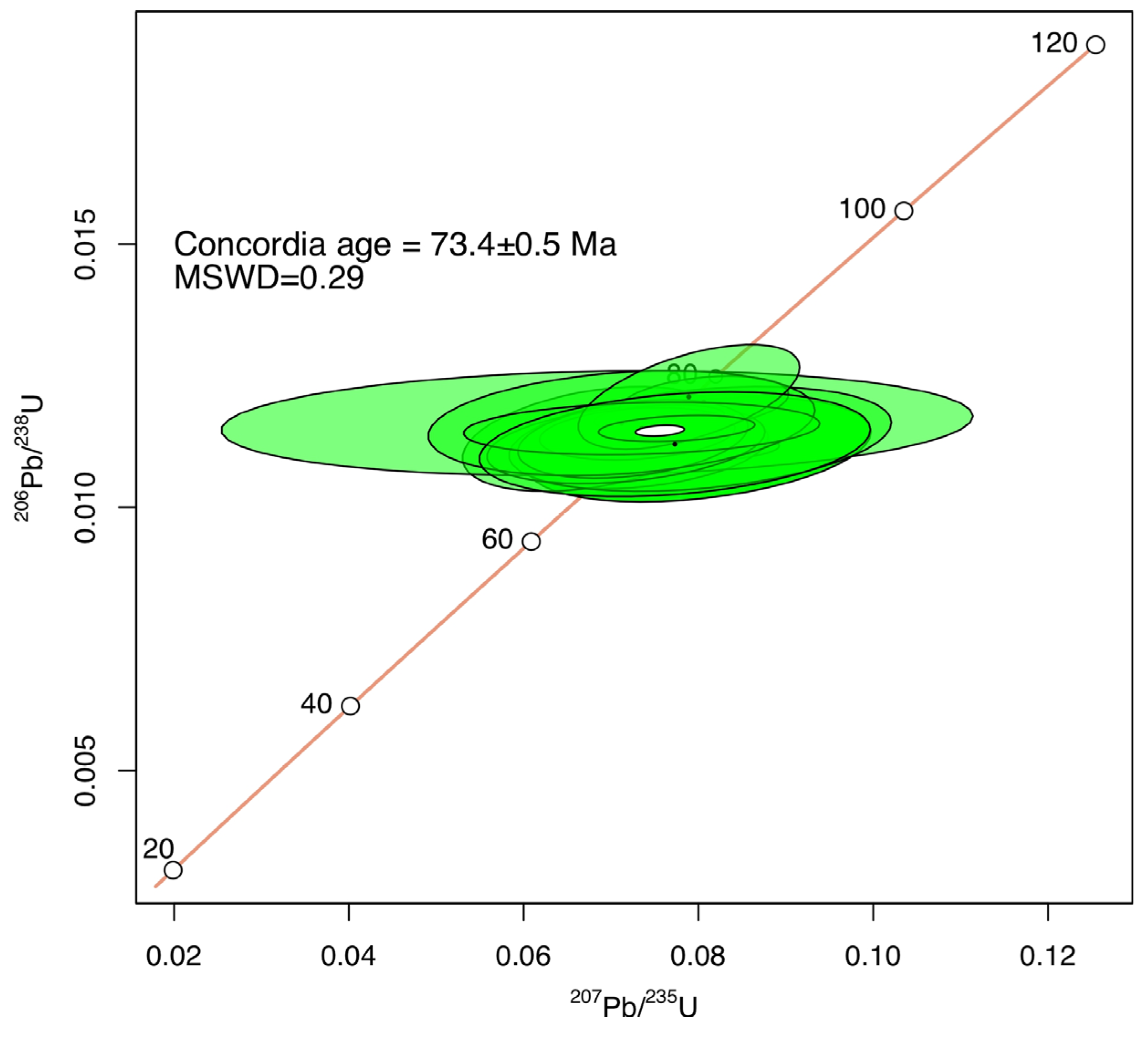
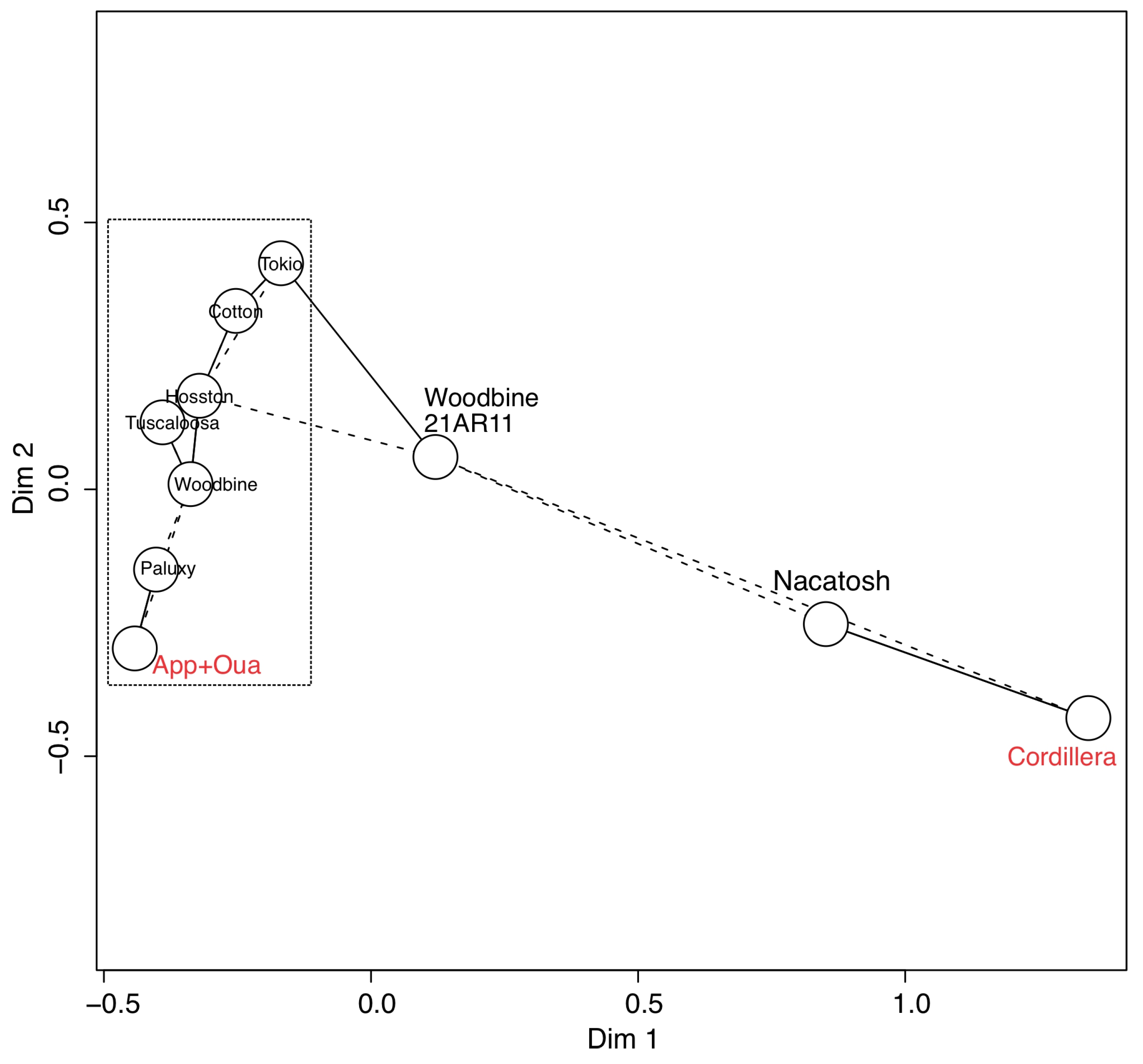

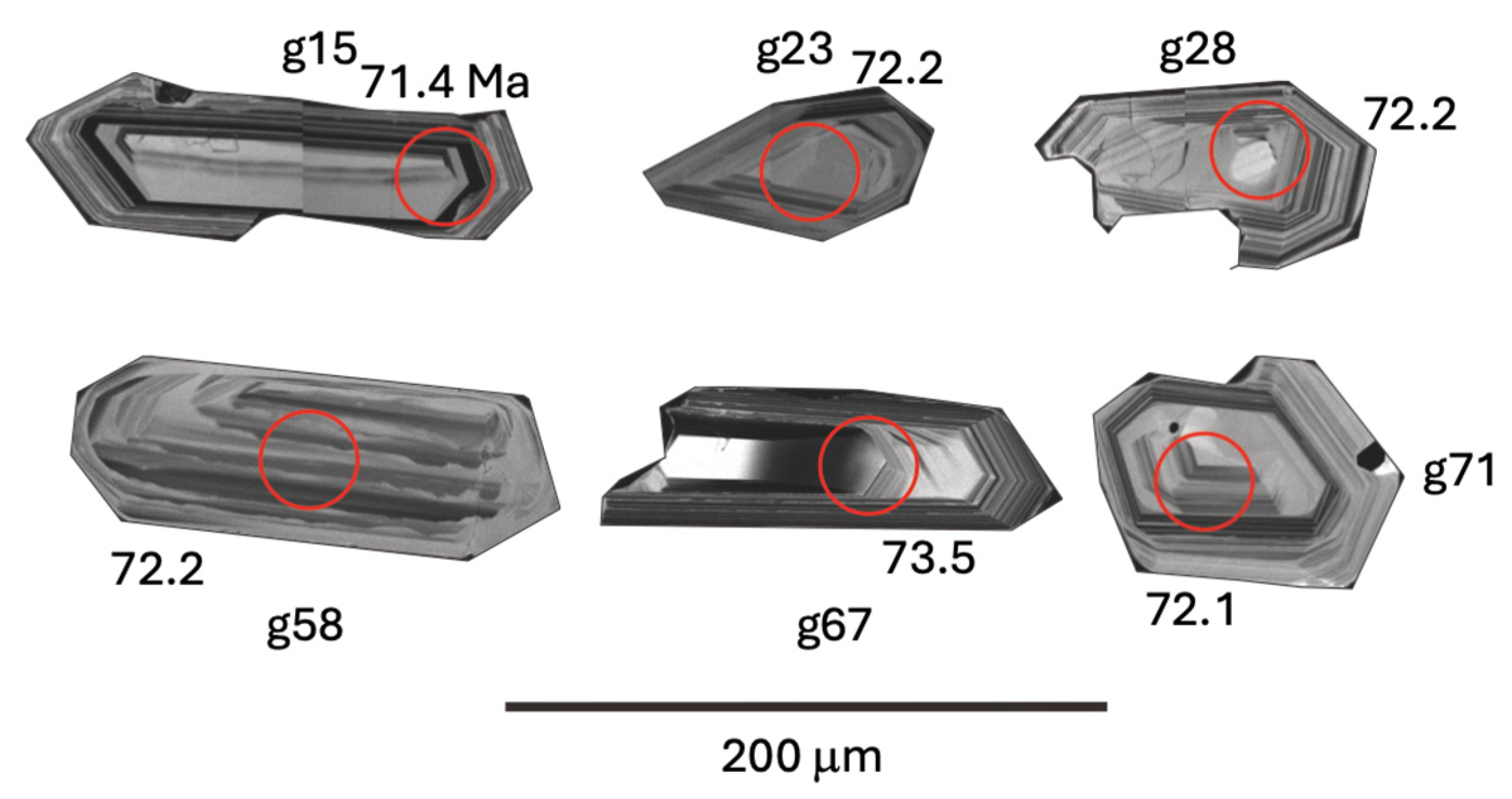
| Samples | Unit | Unit Age | Well | Depth | Latitude | Longitude | Youngest | Oldest | Methods |
|---|---|---|---|---|---|---|---|---|---|
| ft | Zircon (Ma) | Zircon (Ma) | |||||||
| Core | |||||||||
| FM3200 | Tuscaloosa | Late K | Friend Mable #1 | 3200–3300 | 33.11699 | −93.7060 | 394 | 1938 | SIMS |
| MCK4686 | Hosston | Early K | Mckean B-1 | 4686–4821 | 33.36063 | −93.4068 | 326 | 2757 | SIMS |
| NIP6300 | Hosston | Early K | Nipper Well | 6300–6400 | 33.18546 | −93.3254 | 395 | 3179 | SIMS, LA |
| NIP6400 | Hosston | Early K | Nipper Well | 6400–6500 | 33.18546 | −93.3254 | 365 | 2591 | SIMS, LA |
| NIP6500 | Hosston | Early K | Nipper Well | 6500–6600 | 33.18546 | −93.3254 | 317 | 2526 | SIMS |
| NIP6600 | Hosston | Early K | Nipper Well | 6600–6700 | 33.18546 | −93.3254 | 329 | 3511 | SIMS |
| MCK5600 | Cotton Valley | Late J | Mckean B-1 | 5600–5850 | 33.36063 | −93.4068 | 308 | 3558 | SIMS |
| Outcrop | |||||||||
| 21AR01 | Nacatosh | Late K | 32.12249 | −93.09441 | 71 | 1714 | LA | ||
| 21AR07 | Tokio | Late K | 34.03459 | −93.45431 | 321 | 2565 | LA | ||
| 21AR11 | Woodbine | Late K | 34.03900 | −93.86958 | 89 | 2606 | LA | ||
| 21AR23 | Woodbine | Late K | 33.93437 | 94.35956 | 384 | 2699 | LA | ||
| 21AR24 | Woodbine | Late K | 33.98196 | −93.96825 | 221 | 2783 | LA | ||
| 21AR10 | Paluxy | Early K | 34.06744 | −93.90273 | 319 | 2576 | LA | ||
| N American Age Provinces | Max Age | Min Age | Cotton Valley | Hosston | Paluxy | Tuscaloosa | Woodbine | Tokio | Nacatoch |
|---|---|---|---|---|---|---|---|---|---|
| Ma | Ma | n = 47 | n = 203 | n = 72 | n = 49 | n = 122 | n = 47 | n = 57 | |
| Cordillera | 265 | 55 | 0% | 0% | 0% | 0% | 8% | 0% | 67% |
| Alleghanian | 320 | 265 | 4% | 0% | 1% | 0% | 0% | 0% | 0% |
| Acadian | 440 | 320 | 11% | 10% | 6% | 8% | 11% | 13% | 4% |
| Taconic | 490 | 440 | 11% | 4% | 4% | 0% | 4% | 9% | 2% |
| Gondwanan Terranes | 900 | 500 | 28% | 22% | 6% | 27% | 11% | 13% | 0% |
| Grenville | 1350 | 900 | 26% | 37% | 63% | 45% | 43% | 51% | 14% |
| Mid Cont Granite-Rhyolite | 1600 | 1350 | 9% | 7% | 17% | 12% | 11% | 6% | 9% |
| Yavapai-Mazatzal | 1800 | 1600 | 4% | 9% | 1% | 6% | 7% | 4% | 5% |
| Trans-Hudson/Penokean | 1900 | 1800 | 2% | 1% | 1% | 2% | 1% | 2% | 0% |
| Superior Province | 2500 | 6% | 9% | 1% | 0% | 5% | 2% | 0% |
| Cotton | Hosston | Paluxy | Tuscaloosa | Wood23 + 24 | Wood 11 | Tokio | Nacatoch | |
|---|---|---|---|---|---|---|---|---|
| Appala-Ouachita as reference | ||||||||
| Likeness | 0.45 | 0.61 | 0.76 | 0.63 | 0.70 | 0.45 | 0.55 | 0.15 |
| Similarity | 0.76 | 0.88 | 0.94 | 0.86 | 0.92 | 0.74 | 0.85 | 0.24 |
| Western Cordillera as reference | ||||||||
| Likeness | 0.09 | 0.06 | 0.05 | 0.05 | 0.06 | 0.15 | 0.06 | 0.38 |
| Similarity | 0.23 | 0.12 | 0.09 | 0.10 | 0.16 | 0.36 | 0.13 | 0.63 |
Disclaimer/Publisher’s Note: The statements, opinions and data contained in all publications are solely those of the individual author(s) and contributor(s) and not of MDPI and/or the editor(s). MDPI and/or the editor(s) disclaim responsibility for any injury to people or property resulting from any ideas, methods, instructions or products referred to in the content. |
© 2025 by the authors. Licensee MDPI, Basel, Switzerland. This article is an open access article distributed under the terms and conditions of the Creative Commons Attribution (CC BY) license (https://creativecommons.org/licenses/by/4.0/).
Share and Cite
Zou, H.; King, D.T., Jr.; Benton, M.; Webb, Z. Provenance Variations of Cretaceous Sandstones from Arkansas and Drainage Reorganization in Southern USA: Evidence from Detrital Zircon Ages. Geosciences 2025, 15, 133. https://doi.org/10.3390/geosciences15040133
Zou H, King DT Jr., Benton M, Webb Z. Provenance Variations of Cretaceous Sandstones from Arkansas and Drainage Reorganization in Southern USA: Evidence from Detrital Zircon Ages. Geosciences. 2025; 15(4):133. https://doi.org/10.3390/geosciences15040133
Chicago/Turabian StyleZou, Haibo, David T. King, Jr., Mackenzie Benton, and Zain Webb. 2025. "Provenance Variations of Cretaceous Sandstones from Arkansas and Drainage Reorganization in Southern USA: Evidence from Detrital Zircon Ages" Geosciences 15, no. 4: 133. https://doi.org/10.3390/geosciences15040133
APA StyleZou, H., King, D. T., Jr., Benton, M., & Webb, Z. (2025). Provenance Variations of Cretaceous Sandstones from Arkansas and Drainage Reorganization in Southern USA: Evidence from Detrital Zircon Ages. Geosciences, 15(4), 133. https://doi.org/10.3390/geosciences15040133







